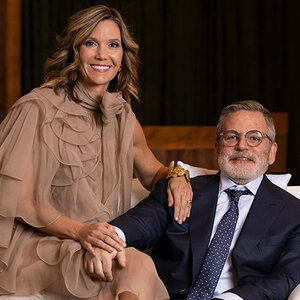Margaret Goldberg, President and CEO, Christopher & Dana Reeve Foundation: Spinal cord injury research at a hopeful and critical juncture
November 23, 2021
The newly appointed president and CEO of the Christopher & Dana Reeve Foundation, Maggie Goldberg, has spent twenty years with the foundation, providing leadership, management, and vision to help establish the only national paralysis-focused organization centered around a dual mission — "Today’s Care. Tomorrow’s Cure®." In addition, by overseeing the foundation’s National Paralysis Resource Center, Goldberg brought to the role her personal experience of suffering a C2 vertebrae injury at age 16 — an injury from which she fully recovered, but which catalyzed her work on behalf of the paralysis community. Most recently, she served as the chief operating officer of the foundation and before that was the senior vice president of marketing and communications. In her new role as president and CEO, she plans to launch a modern approach to the foundation’s scientific endeavors and establish new collaborative partnerships to bring greater awareness and attention to the needs of the paralysis community.
PND asked Goldberg about her plans to launch a modern approach to the foundation’s scientific endeavors, the development and delivery of treatments that move the field closer to cures for spinal cord injury, new partnerships she’d like to align the foundation with, the current status of stem cell research and other therapies, and leading the National Paralysis Resource Center.
Philanthropy News Digest: You’ve indicated that you plan to launch a modern approach to the foundation’s scientific endeavors as CEO. Could you share a little about those plans and how you envision implementing them?
Maggie Goldberg: Since 1982, the Reeve Foundation has awarded over $140 million to a vast network of researchers worldwide. When we began, spinal cord research was in its infancy and was considered the “graveyard of neurobiology.” Many were given no hope of recovery because the prevailing dogma was that the spinal cord was incapable of repair or regeneration once damaged. However, we know much more now, and — finally — innovative therapies and interventions are on the horizon.
To that end, one of my highest priorities is launching a modern approach to the foundation’s scientific endeavors with a new platform for funding collaborative research from the bench to the bedside, designed to address critical roadblocks along the scientific continuum and accelerate progress toward meaningful therapeutics.
Progress has been steadily made in understanding the biological mechanisms of the condition, and now we must bridge the gap between lab-based discovery science and approved therapies that bring real help to people.
But spinal cord injuries (SCI) are incredibly complex, and every injury is unique. It is widely acknowledged that cures for SCI will require a combinatorial approach, a combination of interventions, devices, drugs, and/or surgical. Progress has been steadily made in understanding the biological mechanisms of the condition, and now we must bridge the gap between lab-based discovery science and approved therapies that bring real help to people.
PND: One of the foundation’s stated goals is to develop and deliver real-world treatments that move the field closer to cures for spinal cord injury. In what ways is the foundation contributing to that goal?
MG: Our research approach has always been and continues to unite the brightest minds in the field and pursue every opportunity to enhance the health and quality of life of individuals living with paralysis by translating scientific breakthroughs into vital new therapies.
Take, for example, The Big Idea, the groundbreaking study at the University of Louisville Kentucky Spinal Cord Injury Research Center, which, with critical funding from the Reeve Foundation, is helping patients living with SCI dramatically improve their quality of life — including the previously impossible task of walking overground. The Big Idea is the first prospective, randomized clinical trial of implantable epidural stimulation for chronic SCI patients. Participants in the trial have been sharing their experiences. They are incredible — no longer needing medications for pain and showing recovery of various autonomic functions, voluntary movement, and even standing and walking, for instance. We look forward to the completion of the study and its impact on the field.
We’ve also invested in cure-focused advances led by industry leaders, such as Onward, a Netherlands-based company developing breakthrough technology — currently in global clinical trials — that delivers targeted, electrical stimulation of the spinal cord to restore movement and other functions. That partnership includes financial support to help bring these technologies to market faster to help our patients. Similarly, our investment with biotech startup Axonis supports the advancement of innovative therapeutics with the potential to enable an intrinsic ability of the central nervous system to resist degeneration and promote regeneration.
PND: Do you believe there is sufficient funding available to push forward therapeutic development for spinal cord injuries?
MG: Simply put, no. But the field of SCI research is at a hopeful and critical juncture. While progress has been made, greater public awareness is necessary to push through to achieve our mission. Equally crucial is global coordination and collaboration among SCI stakeholders and purposeful investors to support all aspects of therapeutic development — from clinical trial design to regulatory approval to reimbursement and more. Together, we can go faster and farther. We can’t do it alone.
PND: What kinds of partnerships are you looking for that would best serve the needs of the foundation?
MG: The Reeve Foundation is always looking for creative, collaborative, strategic partners to advance our dual mission of “Today’s Care. Tomorrow’s Cure.®” — set forth by our founders, Christopher and Dana Reeve, to provide a continuum of hope for individuals living with paralysis worldwide.
We’ve launched several new partnerships in just the last two years that illustrate our more extensive mission-driven approach. This past spring, we joined Spinal Injuries Ireland (SII) on a new alliance to cultivate connections and expand support for the SCI community fostering the sharing of best practices, expanding services and educational content, and enabling collaborative fundraising opportunities in the U.S. and Ireland. Initially, the alliance is focusing on peer mentoring, a flagship service of both organizations.
We’ve also formed an alliance with the International Spinal Research Trust (ISRT), a joint strategic approach to research focusing on accelerating the progress of therapies and their delivery to the millions of people around the world living with the life-altering effects of paralysis. Specifically, the alliance is funding grants that support combinatorial interventions, innovative protocols and broader stakeholder engagement for fast-tracking these interventions through the translation stage.
In late 2020, we launched a collaboration with Houston’s Rex A.W. Marco, M.D., a nationally renowned spinal surgeon and musculoskeletal oncologist paralyzed in a bicycle accident. The Rex Marco, M.D., Fund of the Christopher & Dana Reeve Foundation (the Marco Fund) was created with a $1.1 million gift from Dr. Marco’s Spine and Extremity Tumor Research Endowment and is helping accelerate groundbreaking research toward cures for SCI. Dr. Marco now serves as chief medical ambassador for Reeve Research Collaborations and joins the Reeve Foundation Quality of Life Grant Program Committee, which reviews nonprofit grant proposals for projects and initiatives that impact and empower people living with paralysis, their families, and caregivers.
PND: You broke your C2 vertebrae at age 16, though you recovered fully; what did you learn from that experience, and how has it impacted your work with the foundation?
MG: When I was 16 years old, I broke my C2 vertebrae as a passenger in a car accident. My mother became my full-time caregiver. I saw the sacrifices she made to help me. Later in life, the caregiving roles reversed when my mother had a stroke that paralyzed her. I learned there are so many aspects of this injury, and it set me on a mission-driven career path to work and advocate for the paralysis community.
The doctors told me that I was just centimeters away from having the same injury level as Christopher Reeve. I recovered fully, but I realized from that experience the critical need to find cures as soon as possible and the challenges of accessibility in our society. That’s why I’m so committed to the Reeve Foundation’s mission — we must improve the quality of life for our community members and their caregivers and loved ones while we fervently search for cures.
I’ve now been with the foundation for more than twenty years and worked closely with Christopher and Dana — today, it’s my honor and privilege to continue their legacy of ensuring that people living with paralysis are supported to live empowered and independent lives.
The doctors told me that I was just centimeters away from having the same injury level as Christopher Reeve. I recovered fully, but I realized from that experience the critical need to find cures as soon as possible and the challenges of accessibility in our society.
PND: You worked closely with Christopher and Dana Reeve to help establish their foundation’s dual mission. What can we learn from their example?
MG: Christopher and Dana continue to be a source of tremendous inspiration, and their legacy of work on behalf of the paralysis community is strong and enduring. Under Christopher’s leadership, the Reeve Foundation became the preeminent spinal cord research foundation, funding some of the earliest discoveries in basic science and demystifying the centuries-old view that the spinal cord could never be repaired. He also fought to increase research funding and attention at a federal level by regularly testifying in front of Congress as a patient advocate.
It is humbling to comprehend how Christopher, who was living with quadriplegia and dependent on a ventilator for the last decade of his life, could make such an indelible impact on the world. The legacy of his deeds, even more than the celebrity of his career, continues to create a sense of awe for his heroism.
Dana is primarily remembered for establishing the Reeve Foundation’s quality of life initiatives. She said that when Christopher was injured, it felt like landing on the moon and not knowing how to navigate their changing life. While her husband fought for a cure, Dana wanted to build a framework of support for individuals, families, and caregivers impacted by paralysis, modeled after her personal experiences and challenges.
She created our Quality of Life Grants program to aid organizations working to address the daily challenges of living with a disability. She co-founded our National Paralysis Resource Center (NPRC), a first-of-its-kind resource — today supported by a cooperative agreement with the Administration for Community Living — that provides information to people around the world with desperately needed support. Through the NPRC, we provide a wide range of information about living with and managing paralysis, such as support groups and sources for equipment, as well as answers for a myriad of inquiries on insurance and governmental bureaucracies.
Christopher and Dana were an incredible team, and the lessons they’ve imparted continue to drive our foundation and offer hope to all those impacted by paralysis.
PND: Christopher Reeve argued passionately for funding stem-cell research in the hope of repairing nerve damage. What do you believe the future holds concerning new technologies and developments?
MG: Christopher worked diligently to advocate on behalf of the SCI community, particularly for increased funding from both the public and private sectors to treat and one day cure spinal cord injury — as well as cure other neurological conditions, including Parkinson’s, Alzheimer’s, multiple sclerosis (MS), amyotrophic lateral sclerosis (ALS), and stroke. Today, we’re closer than ever to his vision of a world of empty wheelchairs.
All one needs to do is look at the incredible science underway, such as the work of the Chet Moritz laboratory at the University of Washington. Dr. Moritz has married his knowledge of biology with the promise of technology to “hotwire” the damaged nervous system and restore movement to paralyzed limbs. One of the study participants in Dr. Moritz’s lab is today able to play the guitar for several hours a day, more than thirteen years after a diving accident left him with an incomplete SCI and minimal arm and hand function. Scientists like Dr. Moritz are taking on the challenge of curing SCI because they know it can be done in a matter of years, not decades.
PND: Recently there have been developments in treatment for spinal cord injuries that affect the hands and arms — based on research the Reeve Foundation helped fund. The foundation’s The Big Idea initiative has also met with some success. Can you share your thinking behind that initiative and the outlook for more successes like those?
MG: In 2014, the Reeve Foundation unveiled unprecedented research on epidural stimulation in which four young men, each living with an SCI that left them completely paralyzed below their individual injury level, recovered voluntary movements and the ability to stand. It was this investigation that led to The Big Idea, groundbreaking research led by the University of Louisville and funded by the Reeve Foundation that has created a movement to transform what it means to be living with an SCI.
The Big Idea will be fully enrolled by next summer. We’re proud that the $9.4 million the foundation has invested in the study has been leveraged by the researchers to secure an additional $31 million in funding for epidural stimulation science.
This is just the start, however, and it is the foundation’s highest priority to identify the most promising therapies in the pipeline and accelerate the pace of research to completely change what it means to be living with paralysis.
it is the foundation’s highest priority to identify the most promising therapies in the pipeline and accelerate the pace of research to completely change what it means to be living with paralysis.
PND: You oversaw the National Paralysis Resource Center, which emphasizes “Living with Paralysis” and is a resource for the newly paralyzed, their family members, and other caregivers. Why did the foundation decide to create a portal like this? And what impact has it had so far?
MG: Our National Paralysis Recourse Center is the only national program that directly serves the 5.4 million Americans living with MS, ALS, stroke, spina bifida, spinal cord injury, cerebral palsy, and other forms of paralysis.
We’re very proud to have operated the NPRC for nineteen years — we will celebrate its twentieth anniversary in 2022 — and recently secured an additional five years of funding through our cooperative agreement with the Administration for Community Living (ACL).
In partnership with the ACL, the NPRC works to combat social isolation while pursuing health equity and inclusion for individuals with all forms of paralysis and their family members through a vast network of services and educational resources. These include a team of certified, trained information specialists who are often the first port of call for those newly injured or diagnosed with paralysis and who can answer questions in a hundred and seventy languages; our Peer & Family Support Program, a national network offering peer-to-peer connections to individuals and family members impacted by paralysis; the Quality of Life Grants Program, which has awarded over $34 million to fund nearly thirty-four hundred community projects in all fifty states and Puerto Rico since 1999; our Military & Veterans Program; and more.
Since its opening in 2002, more than a hundred and ten thousand people have received one-on-one assistance from the NPRC, accessing vast resources and free personalized support.
—Lauren Brathwaite





